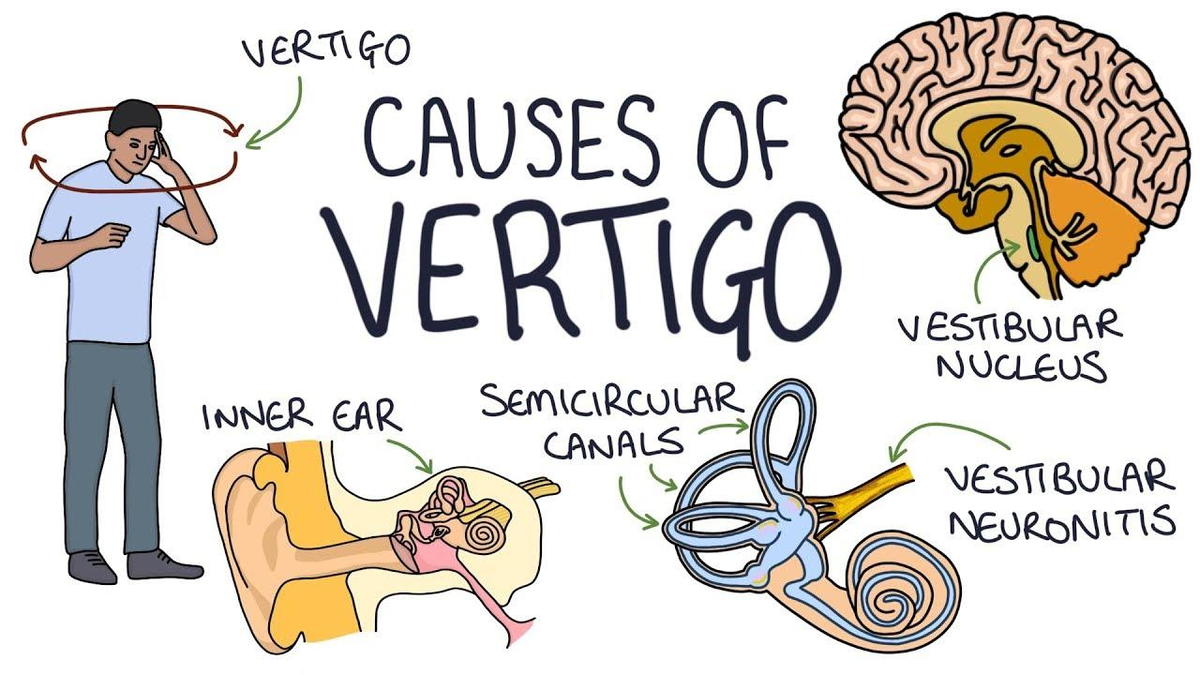What to take for vertigo – When the world around you spins, what do you take for vertigo? This guide explores the causes, symptoms, diagnosis, treatment options, home remedies, and lifestyle modifications for this common condition, providing a comprehensive understanding and practical solutions for relief.
Vertigo, a sensation of dizziness or imbalance, can be caused by various underlying conditions. Understanding the triggers and risk factors can help prevent episodes, while timely diagnosis and appropriate treatment can effectively manage symptoms and improve quality of life.
Vertigo Causes
Vertigo is a common symptom that can be caused by a variety of underlying conditions. The most common cause of vertigo is inner ear disorders, such as benign paroxysmal positional vertigo (BPPV), Meniere’s disease, and labyrinthitis. Other causes of vertigo can include neurological issues, such as stroke, multiple sclerosis, and migraines; and other medical conditions, such as heart disease, anemia, and high blood pressure.
Inner Ear Disorders
- Benign paroxysmal positional vertigo (BPPV) is a common cause of vertigo that is caused by a problem with the inner ear. BPPV occurs when small crystals in the inner ear become dislodged and move into the wrong part of the ear.
This can cause sudden episodes of vertigo that are triggered by certain head movements.
- Meniere’s disease is a disorder of the inner ear that can cause vertigo, hearing loss, and tinnitus (ringing in the ears). Meniere’s disease is thought to be caused by a buildup of fluid in the inner ear.
- Labyrinthitis is an inflammation of the inner ear that can cause vertigo, hearing loss, and tinnitus. Labyrinthitis can be caused by a viral infection, bacterial infection, or other medical conditions.
Neurological Issues
- Stroke is a medical condition that occurs when the blood supply to the brain is interrupted. Stroke can cause a variety of symptoms, including vertigo, dizziness, and loss of balance.
- Multiple sclerosis is a chronic neurological disease that affects the brain and spinal cord. Multiple sclerosis can cause a variety of symptoms, including vertigo, dizziness, and fatigue.
- Migraines are a type of severe headache that can cause a variety of symptoms, including vertigo, nausea, and vomiting.
Other Medical Conditions, What to take for vertigo
- Heart disease can cause vertigo due to a decrease in blood flow to the brain. Heart disease can also cause other symptoms, such as chest pain, shortness of breath, and fatigue.
- Anemia is a condition that occurs when the body does not have enough healthy red blood cells. Anemia can cause vertigo due to a decrease in oxygen flow to the brain. Anemia can also cause other symptoms, such as fatigue, weakness, and pale skin.
- High blood pressure can cause vertigo due to an increase in pressure on the blood vessels in the brain. High blood pressure can also cause other symptoms, such as headaches, dizziness, and chest pain.
Vertigo Symptoms
Vertigo is a symptom that describes a sensation of spinning or dizziness, often accompanied by nausea and imbalance. It can range in severity from mild to severe and can last for a few seconds or several hours, depending on the underlying cause.
The most common symptoms of vertigo include:
- Dizziness: A feeling of lightheadedness or giddiness that can make it difficult to stand or walk.
- Imbalance: A loss of balance or coordination that can lead to falls.
- Nausea: A feeling of queasiness or an upset stomach that can sometimes lead to vomiting.
The severity and duration of vertigo symptoms can vary depending on the underlying cause. For example, mild vertigo caused by motion sickness may only last for a few minutes, while severe vertigo caused by a vestibular disorder can last for several hours or even days.
Vertigo Diagnosis: What To Take For Vertigo

Determining the underlying cause of vertigo involves a thorough diagnostic process that considers the patient’s symptoms, medical history, and physical examination findings. Specialized tests may be necessary to confirm the diagnosis and rule out other conditions with similar symptoms.
Vertigo is a common condition that can cause dizziness and nausea. There are a number of different things that can cause vertigo, including ear infections, head injuries, and certain medications. If you are experiencing vertigo, it is important to see a doctor to determine the cause and get the appropriate treatment.
There are a number of different medications that can be used to treat vertigo, including antihistamines, sedatives, and diuretics. In some cases, surgery may be necessary to correct the underlying cause of vertigo. If you are looking for more information on vertigo, you can visit the following website: cure for vertigo sickness . This website provides a wealth of information on vertigo, including symptoms, causes, and treatment options.
Physical Examination
The physical examination is crucial for assessing the patient’s neurological status and identifying signs that may indicate the cause of vertigo. This may include tests such as:
- Nystagmus evaluation:Observing eye movements for involuntary, rapid oscillations that may suggest a vestibular or central nervous system disorder.
- Romberg test:Assessing balance while standing with feet together, eyes open and closed, to detect postural instability.
- Dix-Hallpike maneuver:Moving the patient’s head into specific positions to provoke vertigo and nystagmus, which may indicate benign paroxysmal positional vertigo (BPPV).
Medical History Review
A detailed medical history review helps identify potential risk factors and associated conditions that may contribute to vertigo. This includes:
- Symptoms and their duration
- Associated symptoms (e.g., hearing loss, tinnitus)
- Recent head or neck injuries
- Medications or substances used
- Past medical history (e.g., stroke, migraine)
Specialized Tests
In some cases, specialized tests may be necessary to confirm the diagnosis or rule out other conditions. These may include:
Electronystagmography (ENG)
ENG records eye movements in response to various stimuli, such as caloric stimulation and head movements. It helps evaluate the function of the vestibular system and detect abnormalities.
Videonystagmography (VNG)
Similar to ENG, VNG uses video recordings to capture eye movements and provide a more detailed analysis of nystagmus patterns.
Differential Diagnosis
Differential diagnosis involves considering other conditions that may present with similar symptoms to vertigo, such as:
- Meniere’s disease
- Vestibular neuritis
- Migraine-associated vertigo
- Central nervous system disorders (e.g., stroke, multiple sclerosis)
- Cardiovascular disorders (e.g., orthostatic hypotension)
Vertigo Treatment Options
Vertigo can be effectively managed or treated depending on its underlying cause. Various approaches are available, ranging from medications and physical therapy exercises to surgical interventions in severe cases.
Medications
Medications are commonly prescribed to alleviate vertigo symptoms and address the underlying cause. These include:
- Antihistamines:These medications help reduce dizziness and nausea associated with motion sickness and other forms of vertigo.
- Anticholinergics:These medications block the action of acetylcholine, a neurotransmitter involved in the transmission of signals in the vestibular system. They can be effective in treating vertigo caused by certain inner ear disorders.
- Vestibular suppressants:These medications work by reducing the activity of the vestibular system, which is responsible for balance and spatial orientation. They can be used to treat severe vertigo and nausea.
Physical Therapy Exercises
Physical therapy exercises can be beneficial in improving balance and reducing vertigo symptoms. These exercises aim to retrain the vestibular system and help the brain compensate for balance disturbances.
- Epley maneuver:This exercise is specifically designed to treat benign paroxysmal positional vertigo (BPPV), a common cause of vertigo caused by dislodged calcium crystals in the inner ear.
- Brandt-Daroff exercises:These exercises involve a series of head and body movements that help improve balance and reduce dizziness.
Surgical Interventions
In rare cases, surgical interventions may be necessary to treat severe or persistent vertigo that does not respond to other treatments. These procedures aim to correct underlying structural abnormalities or damage in the vestibular system or other parts of the brain involved in balance.
- Vestibular nerve section:This surgery involves cutting the vestibular nerve, which transmits signals from the inner ear to the brain. It can be effective in treating severe vertigo caused by vestibular nerve damage.
- Labyrinthectomy:This surgery involves removing the labyrinth, the inner ear structure responsible for balance and hearing. It is typically performed as a last resort for severe and intractable vertigo.
Vertigo Home Remedies and Lifestyle Modifications

Vertigo can be a distressing condition, but there are several simple home remedies and lifestyle modifications that can help alleviate symptoms and improve overall well-being.
Home Remedies
- Rest:Resting in a quiet, dark room can help reduce symptoms of vertigo.
- Hydration:Dehydration can worsen vertigo, so it’s important to stay hydrated by drinking plenty of fluids.
- Dietary changes:Avoiding caffeine, alcohol, and nicotine can help reduce the frequency and severity of vertigo episodes.
- Ginger:Ginger has anti-nausea properties that can help relieve vertigo-related nausea.
- Ginkgo biloba:This herbal supplement may help improve blood flow to the inner ear, reducing vertigo symptoms.
Lifestyle Modifications
- Avoid triggers:Identifying and avoiding triggers that worsen vertigo, such as bright lights, loud noises, or certain head movements, can help reduce symptoms.
- Manage stress:Stress can trigger or worsen vertigo, so it’s important to find healthy ways to manage stress, such as exercise, meditation, or yoga.
- Vestibular rehabilitation:This type of physical therapy can help improve balance and reduce vertigo symptoms.
- Medications:In some cases, medications may be prescribed to control vertigo symptoms, such as anti-nausea medications or vestibular suppressants.
Closing Summary
Whether you’re experiencing occasional dizziness or chronic vertigo, this guide provides valuable insights and actionable steps to alleviate symptoms, improve balance, and regain control over your daily life. Remember, vertigo is manageable, and with the right approach, you can find relief and regain your equilibrium.
